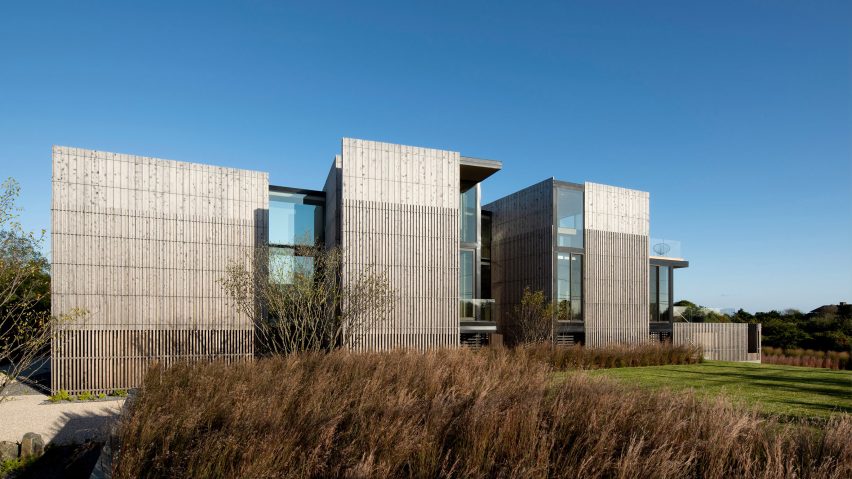US firm Bates Masi Architects has lifted this New York home above the ground and added lower-level screens to let water pass underneath, helping ensure that "flooding becomes a non-threatening event".
Named after the Mohegan tribe's word for ocean, the Kiht'han house is located in Sagaponack, a seaside village on Long Island. The home sits on a one-acre property that straddles agrarian and coastal landscapes.
Bates Masi Architects, which is based in the nearby town of East Hampton, was tasked with creating a home that embraced is natural setting, including the incorporation of flood-protection measures. The architects strove for a solution that met flood protection requirements in a genuine, holistic way.
"Too often the architectural response to flood-prone sites is to distort conventional designs and methods to meet the flood protection requirements, masking the issue at best," said Bates Masi.
"In contrast, the design for this property overlooking a coastal pond and the ocean beyond, celebrates the periodically rising water levels."
Encompassing 5,000 square feet (465 square metres), the home consists of "vertical volumes" placed at different angles and connected by glass-enclosed bridges. The team elevated the home and broke it up into different parts so that water can flow around the residence, reducing the "hydrodynamic pressure of coastal flooding".
"Perched safely above, flooding becomes a non-threatening event, a periodic change in the home's relationship with the ground," the firm continued.
"Rather than hiding the flood damage prevention measures, the design takes advantage of them, thereby embracing the duality of the wetland landscape to intertwine nature and built form," it added.
The placement of each volume was governed by the interior programme and a desire to provide views of the natural landscape.
On the north side of the house, the architects created a two-storey volume that encompasses four guest rooms. The southern portion of the dwelling contains an open-plan cooking, dining and living area on the ground floor and a master suite up above.
A centrally placed volume houses a foyer, laundry/mudroom, stairs and an elevator on the ground floor, and a family room on the upper level. On the east side of the plan, the team created a single-storey pool house, which adjoins a terrace and swimming pool.
The glazed bridges that connect the different volumes enable occupants to "appreciate the dramatic spaces between them, whether flooded in wet periods or interconnected by flows of native plantings in the typical drier periods".
Exterior walls are clad in large stretches of glass and pale-toned cedar. Drawing upon vernacular traditions, the architects used board-and-batten siding – with a twist.
The lowest portion of the facade is made of battens, which form a screen that allows water to flow under the house. The middle portion consists of both boards and battens, which form an opaque surface that blocks view of neighbouring homes. The top-level comprises boards with thin gaps between them, enabling the passage of light.
The different facade treatments also serve an aesthetic function.
"The transitions between the varying opacities occur along horizontal datum lines that ring the towers, breaking up the verticality of the facades and referencing tide lines left by fluctuating water levels," the team said.
The facade vocabulary is carried indoors. On the ground level, walls are wrapped in wooden boards, which transitions to wainscoting and light-painted walls on the upper storey. The transition is meant to mimic the gradations on the exterior.
"The horizontal datum lines are visually transcribed onto the interior walls by means of material transitions for interior finishes and wall claddings," the firm added.
"This visual link expresses the seamless connection between interior and exterior as one travels throughout the house," it continued.
The home is fitted with earthy finishes and contemporary furnishing, including select pieces by Wyeth, which specialise in mid-century modern decor. Large windows offer extensive views of the terrain, and communal spaces flow through sliding glass doors onto elevated decks, providing opportunities for indoor-outdoor living.
"By creating a homogenous relationship between the architecture and nature, one is constantly reminded of the place in which they reside," the team said. "Natural elements are invited into the home and are experienced on a daily basis, thus becoming a part of everyday life."
Based on Long Island, Bates Masi Architects has completed a number of residential projects in coastal settings, including a slatted wooden home in Annapolis that was created for a sailing family, and a Hamptons dwelling that takes cues from historic lifeguard stations.
Photography is by Bates Masi Architects.
Project credits:
Architect: Bates Masi Architects
Contractor: K Romeo Inc

